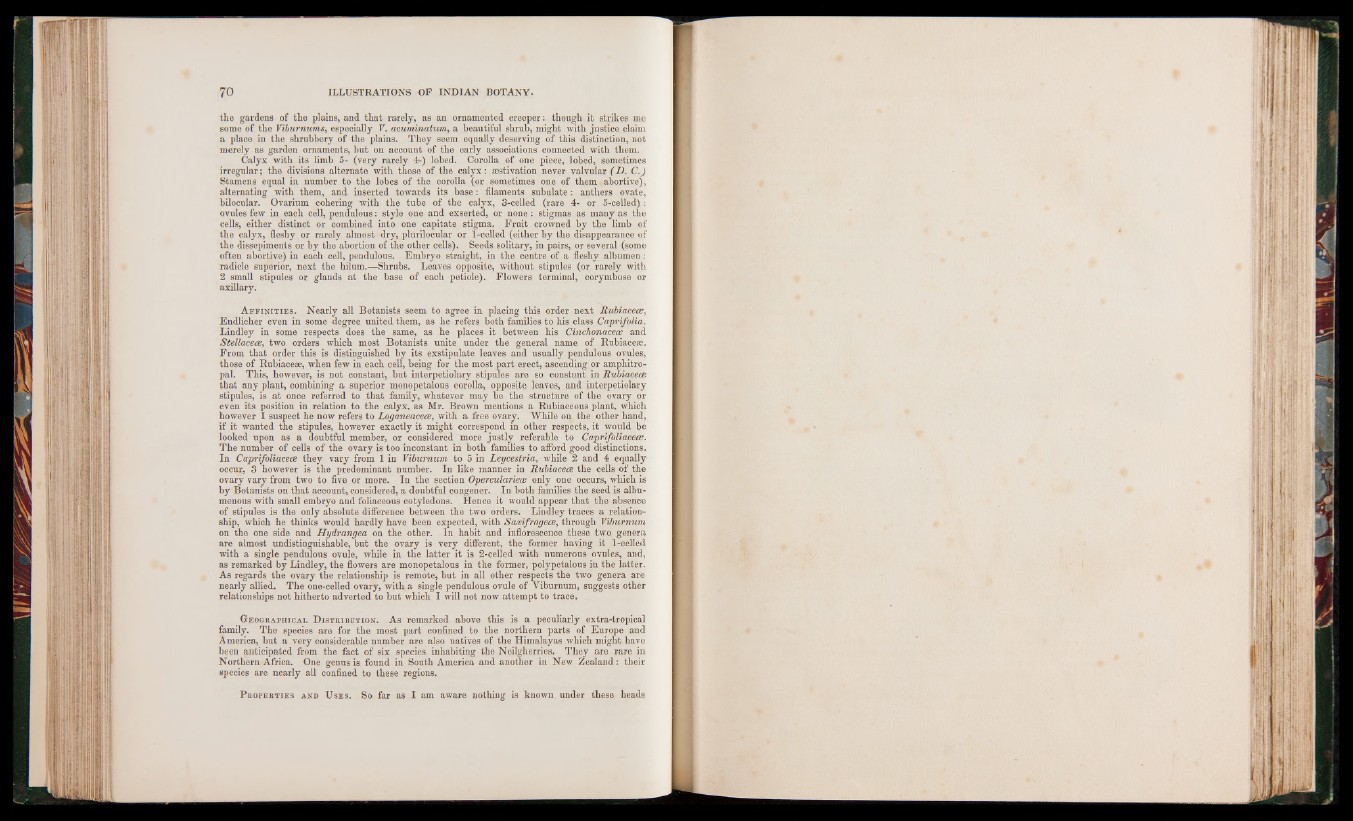
the gardens of the plains, and that rarely, as an ornamented creeper: thongh it strikes me
some of the Viburnums, especially V. acuminatum, a beautiful shrub, might with justice claim
a place in the shrubbery of the plains. They seem equally deserving of this distinction, not
merely as garden ornaments, but on account of the early associations connected with them.
Calyx with its limb 5- (very rarely 4-) lobed. Corolla of one piece, lobed, sometimes
irregular; the divisions alternate with those of the calyx: estivation never valvular (D. C.)
Stamens equal in number to the lobes of the corolla (or sometimes one of them abortive),
alternating with them, and inserted towards its base: filaments subulate: anthers ovate,
bilocular. Ovarium cohering with the tube of the calyx, 3-celled (rare 4- or 5-celled) :
ovules few in each cell, pendulous: style one and exserted, or none: stigmas as many as the
cells, either distinct or combined into one capitate stigma. Fruit crowned by the limb of
the calyx, fleshy or rarely almost dry, plurilocular or 1-celled (either by the disappearance of
the dissepiments or by the abortion of the other cells). Seeds solitary, in pairs, or several (some
often abortive) in each cell, pendulous. Embryo straight, in the centre of a fleshy albumen:
radicle superior, next the hilum.—Shrubs. Leaves opposite, without stipules (or rarely with
2 small stipules or glands at the base of each petiole). Flowers terminal, corymbose or
axillary.
Af f in it ie s . Nearly all Botanists seem to agree in placing this order next Rubiacece,
Endlicher even in some degree united them, as he refers both families to his class Caprifolia.
Lindley in some respects does the same, as he places it between his Cinchonacece and
Stellacece, two orders which most Botanists unite under the general name of Rubiacese.
From that order this is distinguished by its exstipulate leaves and usually pendulous ovules,
those of Rubiacese, when few in each cell, being for the most part erect, ascending or amphitro-
pal. This, however, is not constant, but interpetiolary stipules are so constant in Rubiacece
that any plant, combining a superior monopetalous corolla, opposite leaves, and interpetiolary
stipules, is at once referred to that family, whatever may be the structure of the ovary or
even its position in relation to the calyx, as Mr. Brown mentions a Rubiaceous plant, which
however I suspect he now refers to Loganeacece, with a free ovary. While on the other hand,
if it wanted the stipules, however exactly it might correspond in other respects, it would be
looked upon as a doubtful member, or considered more justly referable to Caprifoliacece.
The number of cells of the ovary is too inconstant in both families to afford good distinctions.
In Caprifoliacece they vary from 1 in Viburnum to 5 in Leycestria, while 2 and 4 equally
occur, 3 however is the predominant number. In like manner in Rubiacece the cells of the
ovary vary from two to five or more. In the section Operculariece only one occurs, which is
by Botanists on that account, considered, a doubtful congener. In both families the seed is albu-
menous with small embryo and foliaceous cotyledons. Hence it would appear that the absence
of stipules is the only absolute difference between the two orders. Lindley traces a relationship,
which he thinks would hardly have been expected, with Saooifragece, through Viburnum
on the one side and Hydrangea on the other. In habit and inflorescence these two genera
are almost undistinguishable, but the ovary is very different, the former having it 1-celled
with a single pendulous ovule, while in the latter it is 2-celled with numerous ovules, and,
as remarked by Lindley, the flowers are monopetalous in the former, polypetalous in the latter.
As regards the ovary the relationship is remote* but in all other respects the two genera are
nearly allied. The one-celled ovary, with, a single pendulous ovule of Viburnum, suggests other
relationships not hitherto adverted to but which I will not now attempt to trace.
Geographical D istribution. As remarked above this is a peculiarly extra-tropical
family. The species are for the most part confined to the northern parts of Europe and
America, but a very considerable number are also natives of the Himalayas which might have
been anticipated from the fact of six species inhabiting the Neilgherries. They are rare in
Northern Africa. One genus is found in South America and another in New Zealand: their
species are nearly all confined to these regions.
P roperties and Uses. So far as I am aware nothing is known, under these heads